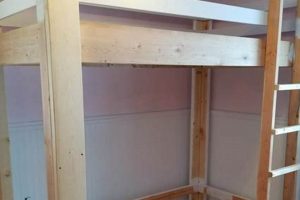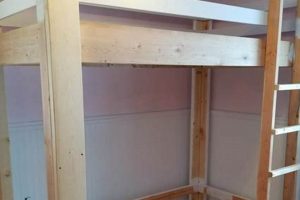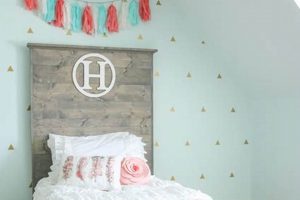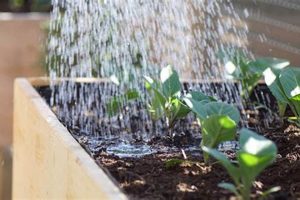The construction of a bed frame that gives the illusion of levitation is a popular do-it-yourself project. This type of furniture design typically conceals the supporting structure beneath the mattress platform, creating a visual effect where the bed appears to float above the floor. An example includes building a platform with recessed legs and incorporating LED lighting underneath to enhance the floating appearance.
Such projects offer several advantages, including cost savings compared to purchasing pre-made versions and the opportunity for customization to fit specific room dimensions and aesthetic preferences. Historically, the desire for unique and visually appealing furniture has driven interest in innovative designs, and this kind of bed aligns with that trend. A floating bed can also create a sense of spaciousness in smaller rooms.
The following discussion will delve into the materials, construction techniques, and safety considerations involved in undertaking this project. Further details will cover design variations and methods for achieving a stable and visually appealing result.
Essential Considerations for Floating Bed Construction
The following outlines key recommendations for successfully constructing a bed that appears to float, ensuring both aesthetic appeal and structural integrity.
Tip 1: Material Selection: Choose high-quality lumber or engineered wood products for the bed frame. Solid wood, such as maple or oak, provides superior strength and stability compared to softer woods. Consider using plywood for the platform surface to ensure even weight distribution.
Tip 2: Concealed Support Structure: Design the support structure carefully, ensuring it is adequately recessed from the visible edges of the bed platform. This recess creates the illusion of levitation. Reinforce the concealed legs with metal brackets for added stability.
Tip 3: Lighting Integration: If incorporating LED lighting, plan the wiring and placement early in the construction process. Low-voltage LED strips offer energy efficiency and can be easily concealed along the recessed edges of the bed frame. Ensure the wiring is properly insulated and meets electrical safety standards.
Tip 4: Weight Distribution: Accurately calculate the load-bearing capacity of the frame and support structure. Account for the weight of the mattress and potential occupants. Distribute the weight evenly across the concealed legs to prevent stress points and potential failure.
Tip 5: Secure Fastening: Utilize robust fasteners, such as screws and bolts, to assemble the bed frame. Apply wood glue in conjunction with fasteners to create strong and durable joints. Regularly inspect the fasteners for tightness and make adjustments as needed.
Tip 6: Leveling and Stability: Ensure the bed frame is perfectly level to prevent rocking or instability. Use adjustable leveling feet on the concealed legs to compensate for uneven floor surfaces. Regularly check the levelness and adjust as necessary.
Tip 7: Edge Finishing: Pay attention to the finishing details of the visible edges of the bed platform. Apply edge banding or trim to conceal the raw edges of the plywood or lumber. Sand and finish the edges smoothly to prevent splinters and enhance the overall aesthetic.
Adhering to these guidelines is crucial for creating a stable, safe, and visually appealing result. Proper planning, material selection, and construction techniques are essential for the longevity and safety of the finished bed.
The concluding sections will address design variations and aesthetic enhancements for creating a truly unique floating bed.
1. Structural Support
The feasibility of a do-it-yourself bed that creates the illusion of floating is directly dependent on the unseen, yet crucial, structural support system. Without a robust and carefully engineered framework, the bed’s platform would be unable to bear the combined weight of the mattress and occupants, leading to potential collapse and rendering the desired floating effect impossible. The design requires a system capable of transferring the load away from the visible perimeter, typically achieved through a central support structure or recessed legs. For instance, a queen-sized bed designed to appear floating might employ a steel frame hidden beneath a wooden platform, effectively distributing the weight across a larger area and minimizing stress on any single point. This foundation is the primary cause of the bed’s stability and longevity.
The importance of a well-designed support system extends beyond mere weight-bearing capacity. It also influences the bed’s overall stability and resistance to movement. Lateral bracing, for example, prevents the bed from swaying or shifting during use, enhancing the user’s comfort and safety. A real-life example of inadequate support can be found in designs that prioritize aesthetics over engineering, resulting in beds that are visually appealing but prone to wobbling or even breaking under normal conditions. The practical significance of understanding this connection lies in the ability to anticipate potential weaknesses and reinforce critical areas during construction, ensuring the bed’s structural integrity.
In summary, structural support is not merely a component of a DIY floating bed, but rather its invisible backbone. The systems design and execution directly determine the bed’s functionality and safety. Challenges in achieving adequate support often stem from a lack of understanding of load distribution principles. This critical aspect highlights the need for careful planning and precise execution in any floating bed project, linking back to the broader theme of combining aesthetic design with sound engineering principles.
2. Weight Distribution
Weight distribution is a paramount consideration in the construction of a bed designed to create the illusion of floating. The concealed support structure must efficiently manage the weight of the mattress and occupants to maintain stability and prevent structural failure. Improper weight distribution compromises the desired floating effect and introduces safety risks.
- Center of Gravity and Support Placement
The location of the center of gravity in relation to the support structure is crucial. The support points, typically recessed legs or a hidden platform, must be strategically positioned to provide adequate support. For instance, a bed with a high center of gravity due to a thick mattress requires more robust and widely spaced supports compared to a bed with a thinner mattress. Failure to account for the center of gravity results in an unstable and potentially dangerous structure.
- Load-Bearing Capacity of Materials
The materials used in the construction of the frame and support structure must possess sufficient load-bearing capacity. Utilizing materials such as high-density hardwood or steel reinforces the bed’s ability to withstand the applied weight. An example includes substituting pine, a softwood, with oak, a hardwood, in the construction of the support legs. Choosing inappropriate materials can lead to deformation or even collapse under load.
- Even Distribution Across Support Points
The weight must be evenly distributed across all support points to prevent stress concentrations. An uneven distribution can occur if the support structure is not level or if one area is significantly weaker than another. Implementing a grid-like support structure beneath the platform helps ensure even distribution. Failure to achieve this results in localized stress and potential structural failure.
- Dynamic Load Considerations
The bed must be designed to withstand dynamic loads, which are the forces generated by movement on the bed. These forces are more complex than static loads and require additional engineering considerations. Incorporating bracing and reinforced joints enhances the bed’s resistance to dynamic loads. Ignoring dynamic load factors leads to premature wear and potential structural failure over time.
Effective weight distribution is fundamental to both the safety and aesthetic success of floating bed construction. Proper planning and execution minimize risk and maximize the bed’s longevity and the illusion of levitation. A design that neglects these factors jeopardizes the structural integrity and defeats the purpose of the project.
3. Recessed Platform
The recessed platform constitutes a core design element in the pursuit of creating a bed that gives the impression of floating. It is essential to achieving the desired visual effect, as it directly influences the degree to which the support structure remains hidden from view. Without this feature, the supporting elements would be readily visible, undermining the illusion of levitation.
- Creating the Illusion of Suspension
The primary role of the recessed platform is to conceal the bed’s support structure. By setting the legs or base inward from the perimeter of the mattress platform, the visible edges appear unsupported, giving the impression that the bed is floating above the floor. A common example involves setting the supporting legs several inches inward, creating a shadow line that further enhances the illusion. This approach is fundamental to the visual deception inherent in the design.
- Impact on Lighting Integration
The recessed nature of the platform provides an ideal space for integrating lighting elements, such as LED strips. This concealed lighting further accentuates the floating effect by casting a glow beneath the bed, emphasizing the shadow line and making the visible platform appear less connected to the floor. The strategic placement of lighting within the recessed area not only contributes to the aesthetic appeal but also enhances the perception of depth and separation from the ground.
- Design Considerations for Stability
While the recessed platform is crucial for the floating effect, its design must also account for stability and weight distribution. The internal support structure must be robust enough to handle the load without compromising the visual illusion. This often involves using a combination of strong materials and careful engineering to ensure that the recessed legs or base can adequately support the weight of the mattress and occupants. Overlooking stability considerations can lead to structural failure and negate the intended aesthetic.
- Aesthetic Customization Opportunities
The recessed platform offers significant opportunities for aesthetic customization. The visible edges can be finished with various materials, such as wood, metal, or laminate, to complement the overall design. Additionally, the recessed area can be painted or textured to create visual contrast and further enhance the floating effect. The flexibility in design allows for a high degree of personalization, ensuring that the final product aligns with individual preferences and interior decor.
In summary, the recessed platform is an indispensable component in the design and construction of beds intended to appear as though they are floating. Its impact extends beyond mere aesthetics, influencing stability, lighting integration, and customization options. A careful consideration of its design and implementation is essential for achieving a visually compelling and structurally sound floating bed.
4. Concealed Lighting
Concealed lighting serves as a pivotal element in enhancing the illusion of levitation associated with do-it-yourself bed construction. Its integration is not merely decorative; it fundamentally alters the perception of space and support.
- Enhancing the Floating Effect
Subtle illumination, often achieved with LED strips, strategically placed beneath the bed platform creates a visual separation between the structure and the floor. The light, hidden from direct view, casts a soft glow that emphasizes the shadow line, making the bed appear less grounded. For example, a strip of warm white LEDs positioned along the recessed edge of the platform generates an ambient light that contributes to the ethereal quality of the bed. This effect is lost without the precise concealment of the light source.
- Emphasizing Shadow and Depth
The strategic use of concealed lighting manipulates shadow and depth perception. By directing light upwards from beneath the bed, the areas directly above the light source remain relatively bright, while areas further away fall into shadow. This contrast heightens the sense of depth and reinforces the visual detachment of the bed from its surroundings. Consider a room where the only light source is the concealed lighting under the bed; the resulting shadows exaggerate the floating effect, making the bed a focal point of visual interest.
- Camouflaging Support Structures
Effective concealed lighting helps to mask any visible elements of the support structure. By illuminating the area directly beneath the platform, attention is drawn away from any partially visible legs or frame components. For instance, black-painted support legs become almost invisible when bathed in soft, diffused light from below. This camouflage is crucial for maintaining the seamless illusion of a floating bed.
- Creating Ambiance and Mood
Beyond the primary function of enhancing the floating effect, concealed lighting also contributes to the overall ambiance of the bedroom. The ability to adjust the color and intensity of the light allows for the creation of different moods, from a calming and relaxing atmosphere to a more vibrant and energetic setting. Imagine a bedroom where the under-bed lighting is synchronized with the room’s smart lighting system, allowing for dynamic changes in color and brightness to suit different activities and preferences.
In conclusion, the integration of concealed lighting transcends simple illumination; it is a deliberate manipulation of light and shadow that fundamentally reinforces the illusion of a floating bed. Its effective application requires careful planning and execution, but the resulting visual impact significantly elevates the overall design.
5. Aesthetic Finishing
Aesthetic finishing represents the culmination of the do-it-yourself floating bed project, serving as the defining characteristic that distinguishes a functional piece of furniture from a visually compelling design. This stage involves refining the visible surfaces and edges to enhance the overall aesthetic and seamlessly integrate the bed into the intended environment.
- Edge Treatment and Material Selection
The treatment of the platform’s edges is crucial for both visual appeal and user safety. Sharp or unfinished edges detract from the floating illusion and pose a potential hazard. Employing edge banding, trim, or rounding the edges significantly enhances the aesthetic. The selection of edge materials, such as wood veneer, metal, or laminate, should complement the overall design and create a cohesive appearance. For instance, a minimalist bed design might feature a simple, clean edge with a natural wood finish, while a more contemporary design could incorporate metal edging for a sleek and modern aesthetic.
- Surface Preparation and Finishing Techniques
Proper surface preparation is essential for achieving a smooth and uniform finish. This involves sanding the wood surfaces to remove imperfections and create a suitable base for the chosen finish. Various finishing techniques can be employed, including staining, painting, varnishing, or applying a clear coat. The selection of finishing products should consider both the desired aesthetic and the durability of the finish. For example, a stain can enhance the natural grain of the wood, while a clear coat provides protection against scratches and wear. The choice depends on the intended style and the level of maintenance desired.
- Integration of Hardware and Details
The integration of hardware, such as screws, bolts, or decorative elements, should be carefully considered to avoid detracting from the overall aesthetic. Concealing hardware or using decorative hardware that complements the design enhances the finished appearance. For instance, using black oxide screws on a dark-stained bed platform creates a subtle, integrated look, while using decorative brass knobs on a drawer incorporated into the platform adds a touch of elegance. Attention to these details contributes to a polished and professional finish.
- Lighting Integration and Concealment
As previously discussed, lighting plays a key role in enhancing the floating effect. The aesthetic finishing stage involves ensuring that the lighting elements are seamlessly integrated into the design and that any wiring or components are effectively concealed. This may involve creating recessed channels for LED strips, covering wiring with trim, or using diffusers to soften the light. The goal is to create a visually appealing and functional lighting system that complements the overall design without being visually obtrusive.
These facets collectively contribute to the aesthetic refinement of a bed, transforming it from a structural object into an artistic element within the bedroom. The meticulous execution of aesthetic finishing ensures that the floating bed achieves its intended visual impact, contributing to a cohesive and visually appealing living space.
6. Material Selection
The selection of materials exerts a decisive influence on the structural integrity, aesthetic appeal, and overall success of any do-it-yourself bed designed to create the illusion of floating. The chosen materials directly impact the bed’s ability to support weight, maintain stability, and achieve the desired visual effect.
- Load-Bearing Capacity and Structural Integrity
The primary function of the bed frame is to support the weight of the mattress and occupants. Therefore, the selected materials must possess sufficient load-bearing capacity to prevent structural failure. Hardwoods such as oak or maple are often preferred for their strength and durability. For instance, substituting a softwood like pine for oak in the construction of the main support structure can compromise the bed’s stability, potentially leading to sagging or collapse. The choice of material directly dictates the bed’s ability to withstand static and dynamic loads, ensuring safety and longevity.
- Weight Considerations and the Floating Illusion
The overall weight of the materials used influences the perceived floating effect. Lighter materials, such as certain types of plywood or engineered wood, can contribute to a more pronounced sense of levitation. However, this must be balanced against the need for adequate structural support. For example, using a lightweight platform combined with a robust, hidden steel frame allows for a visually light upper surface while maintaining structural integrity. The interplay between weight and strength is critical for achieving the desired aesthetic.
- Aesthetic Qualities and Design Cohesion
The aesthetic qualities of the selected materials significantly impact the bed’s overall visual appeal. The color, grain pattern, and texture of the wood, metal, or other materials must complement the intended design aesthetic. For example, a minimalist bed design might utilize light-colored wood with a clean, straight grain, while a more rustic design could incorporate reclaimed wood with a weathered texture. The choice of materials directly contributes to the bed’s ability to integrate seamlessly into the room’s decor and achieve the desired style.
- Durability and Longevity
The durability of the chosen materials influences the bed’s lifespan and resistance to wear and tear. Materials that are resistant to scratches, moisture, and other environmental factors are essential for ensuring the bed’s long-term performance. For instance, using a high-quality finish on the wood surfaces protects against damage and maintains the aesthetic appeal over time. The investment in durable materials translates to a longer lifespan and reduced maintenance requirements.
In conclusion, material selection is not merely a matter of preference but a fundamental aspect of the do-it-yourself floating bed project. The chosen materials directly impact structural integrity, aesthetic appeal, weight distribution, and longevity. Careful consideration of these factors is essential for creating a bed that is both visually stunning and structurally sound, thus achieving the intended effect of a floating bed.
Frequently Asked Questions
The following addresses common inquiries and concerns regarding the design, construction, and safety of creating a floating bed. This information is intended to provide clarity and assist in making informed decisions.
Question 1: What are the primary safety concerns associated with constructing this type of bed?
The most significant safety concern revolves around structural integrity. The concealed support system must adequately bear the weight of the mattress and occupants. Improper design or inadequate material selection can lead to collapse, resulting in potential injury. Furthermore, if integrated, electrical components for lighting must be installed in accordance with safety standards to mitigate fire and shock hazards.
Question 2: How is the illusion of a floating bed achieved, and what are the key design elements?
The floating effect is primarily achieved through a recessed platform and strategic lighting. The support structure is set inward from the perimeter of the mattress, creating a visual gap. Concealed lighting, typically LED strips, illuminates the area beneath the bed, further emphasizing the shadow line and detaching the bed visually from the floor. A clean, minimalist aesthetic amplifies this effect.
Question 3: What types of materials are recommended for building a structurally sound floating bed?
High-quality hardwoods, such as oak or maple, are recommended for the primary support structure due to their superior strength and durability. Plywood or engineered wood products can be used for the platform surface, provided they are adequately supported. Steel reinforcements may be incorporated into the concealed support system for added stability.
Question 4: How does weight distribution impact the stability and longevity of the floating bed?
Even weight distribution is critical for preventing stress concentrations and potential structural failure. The support system must be designed to distribute the load evenly across all support points. Implementing a grid-like support structure beneath the platform is a common technique. Uneven weight distribution can lead to localized stress and premature wear, reducing the bed’s lifespan.
Question 5: What are some common mistakes to avoid when undertaking a DIY floating bed project?
Common mistakes include underestimating the load-bearing capacity requirements, neglecting proper material selection, and failing to adequately plan the concealed support structure. Insufficient bracing, improper fastener usage, and inadequate attention to leveling can also compromise the bed’s stability and aesthetic appeal. Overlooking electrical safety when integrating lighting is a significant error.
Question 6: How can the floating bed design be customized to suit individual preferences and room aesthetics?
Customization options include selecting different edge treatments, surface finishes, and lighting configurations. The platform can be finished with wood veneer, laminate, or paint to complement the room’s decor. Lighting can be adjusted in color and intensity to create different moods. Furthermore, the overall dimensions of the bed can be tailored to fit specific room constraints.
In summary, a successful floating bed requires a comprehensive understanding of structural engineering principles, careful material selection, and meticulous attention to detail. Prioritizing safety and stability is paramount throughout the design and construction process.
The subsequent section will delve into specific design variations and advanced techniques for enhancing the floating bed aesthetic.
Conclusion
The preceding exploration of “floating bed diy” has elucidated the critical elements involved in designing and constructing a bed that achieves the visual effect of levitation. Key considerations encompass structural integrity, weight distribution, material selection, recessed platform design, concealed lighting integration, and aesthetic finishing. Adherence to sound engineering principles and meticulous execution are paramount for ensuring both safety and visual appeal.
The successful implementation of a floating bed project demands a commitment to precision and a thorough understanding of load-bearing requirements. While the aesthetic rewards are considerable, neglecting the foundational aspects of structural design can have serious consequences. The decision to undertake “floating bed diy” should be predicated on a careful assessment of one’s skills, resources, and commitment to safety. Further research and consultation with qualified professionals are encouraged prior to commencement.







